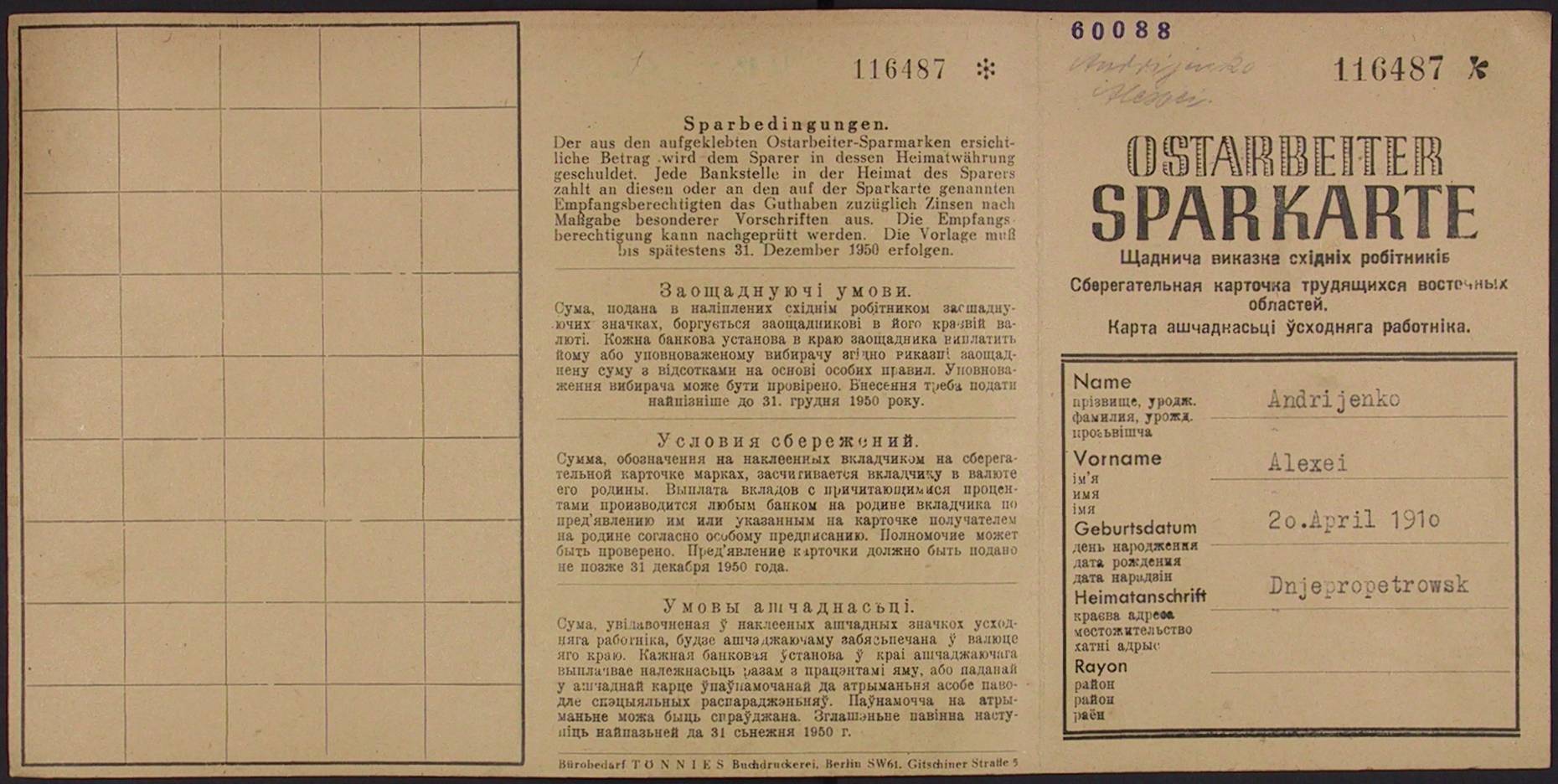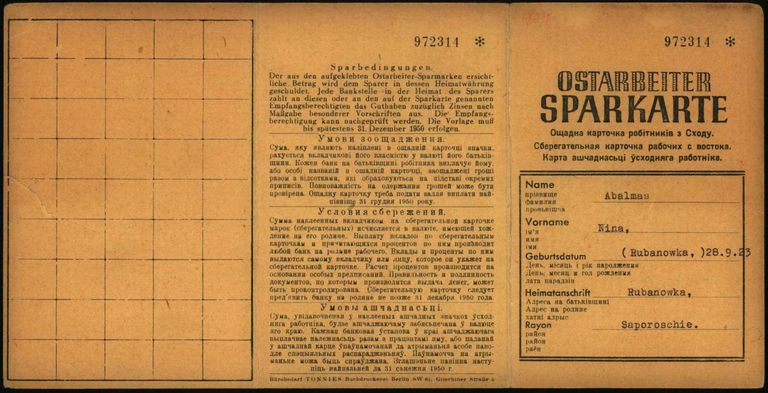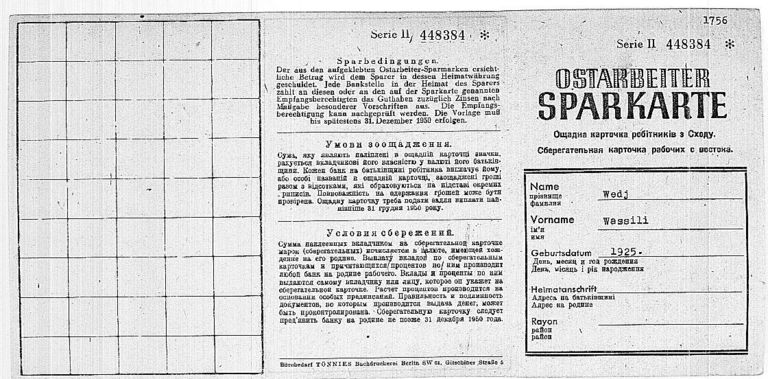Page of
Page/
- Reference
- Intro


Civilian forced laborers from the occupied territories of the Soviet Union, known disparagingly as “Eastern workers” (“Ostarbeiter”), were not allowed to open a savings account or a bank account in the German Reich. The Reich Ministry of Finance introduced a savings scheme specifically for them in the summer of 1942: the Eastern workers savings scheme (Ostarbeitersparen). Soviet civilian laborers were then able to purchase savings stamps that were pasted on to Eastern workers savings cards. In theory, they should have been able to send this money to their families abroad. In practice, however, the savings scheme served to finance the German war effort as funds were rarely transferred.
Civilian forced laborers from the occupied territories of the Soviet Union, known disparagingly as “Eastern workers” (“Ostarbeiter”), were not allowed to open a savings account or a bank account in the German Reich. The Reich Ministry of Finance introduced a savings scheme specifically for them in the summer of 1942: the Eastern workers savings scheme (Ostarbeitersparen). Soviet civilian laborers were then able to purchase savings stamps that were pasted on to Eastern workers savings cards. In theory, they should have been able to send this money to their families abroad. In practice, however, the savings scheme served to finance the German war effort as funds were rarely transferred.
Questions and answers
-
Where was the document used and who created it?
Staff at the Zentralwirtschaftsbank Ukraine (ZWB) in Berlin, and later in Cottbus, issued the savings cards for the Eastern workers savings scheme. Local branches of the Spar- und Girokasse banks as well as credit cooperatives (Kreditgenossenschaften) took over the organization and distribution of the Eastern workers savings cards and stamps, particularly for smaller companies. Large companies such as Krupp received cards and stamps directly from the ZWB.
The personnel departments of the companies and businesses that employed Soviet civilian laborers kept their cards and pasted the stamps on to them. In some cases, Soviet civilian laborers also carried their Eastern workers savings cards with them.
- When was the document used?
The Zentralwirtschaftsbank Ukraine (ZWB) was founded in the spring of 1942 by Erich Koch, the Reich Commissioner for the Ukraine, as a state bank for Ukraine. However, the name is misleading since it was a German bank with its headquarters in Berlin, and later in Cottbus. German companies began receiving Eastern workers savings cards along with an information leaflet in July 1942. The sale of savings stamps continued until the end of the Second World War.
- What was the document used for?
Unlike concentration camp prisoners or prisoners of war, civilian forced laborers received a wage for the work they did. What was left after deducting taxes and other charges as well as the costs of their board and lodging in communal accommodation could in some cases be sent home to their families. However, civilian laborers from the Soviet Union were forbidden to save money or transfer funds abroad. For them, the so-called Eastern workers savings scheme (Ostarbeitersparen) was introduced in 1942 instead. Each month they could buy savings stamps to the value of one, three, five, or ten Reichsmarks from their low salary, and have them pasted onto their savings card. The respective month and year in which they had been purchased were recorded on each savings stamp for the subsequent calculation of the 2.5 percent annual interest promised in theory.
The withdrawal or transfer of money that had been saved was complicated and subject to many conditions. In fact, savings deposits were almost never paid out, and the Soviet civilian laborers were often reluctant to buy the stamps. From September 27, 1944, Soviet civilian laborers were no longer allowed to withdraw or transfer their savings at all. Once the German army had pulled out of the Soviet Union, the savings of Soviet civilian laborers were retained and used to finance the war effort.
In February 1945, the Berlin-based Bank der Deutschen Arbeit took over the Eastern workers savings scheme from the Zentralwirtschaftsbank Ukraine (ZWB), which had administered it up to that point. The savings scheme was then extended to all civilian forced laborers employed in the German Reich. However, the extent to which this plan was actually implemented in the final months of the war is not known. According to the handover letter, over three million Reichsmarks were received in the “Eastern workers saving scheme special account” in January 1945 alone, while only around 43,000 Reichsmarks were paid out. In total, the Eastern workers savings scheme accumulated over 45 million Reichsmarks.
- How common is the document?
Unfortunately, it is not known how many Eastern workers savings cards were issued by the Zentralwirtschaftsbank Ukraine. If Soviet civilian laborers changed jobs, their savings card was handed over to them. Some of these cards are therefore now in the possession of former civilian laborers from the Soviet Union or have been passed on to their descendants. Other cards that ended up in the Arolsen Archives collection came from company archives.
Staff at the International Tracing Service (ITS), the predecessor institution of the Arolsen Archives, placed Eastern workers savings cards in the War Time Card File (Collection 2.2.2.1), which contains 4.2 million documents. Since coherent card indexes were dissolved as a result of this course of action, it is impossible to say how many Eastern workers savings cards, either originals or copies, are held in the Arolsen Archives today. But in the near future, modern computer technology will find the answer: clustering techniques will make it possible to identify Eastern workers savings cards, as well as other documents, and to virtually collate cards of the same type. However, by no means all the Eastern workers savings cards of civilian forced laborers have survived.
- What should be considered when working with the document?
Officially, the Eastern workers savings scheme was voluntary for all Soviet civilian laborers. But in actual fact, employers were urged to ensure that as many of their civilian forced laborers from the Soviet Union as possible participated in the scheme. It was actually a measure that could be used to withhold a portion of civilian forced laborers’ wages without them being asked.
If you have any additional information about this document, please send your feedback to eguide@arolsen-archives.org. New findings can always be incorporated into the e-Guide and shared with everyone.
Variations
Help for documents
About the scan of this document <br> Markings on scan <br> Questions and answers about the document <br> More sample cards <br> Variants of the document


